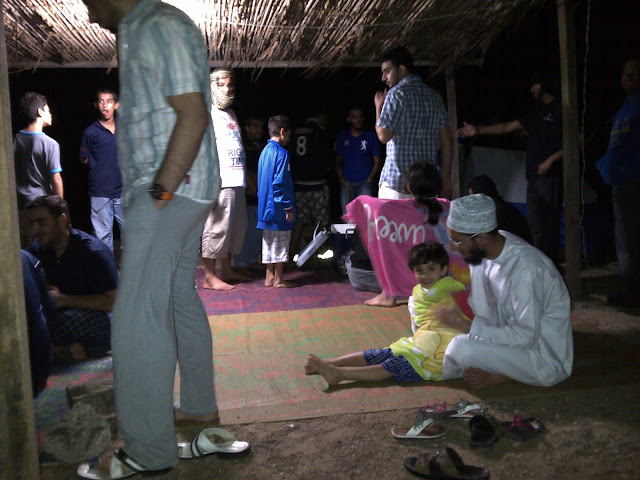Today's blog is written by my hubby--who had a great time and authentic mani experience camping out with some fellow workers in the HR department of his company. I think you'll enjoy it!
Earlier this month I had the pleasure of joining many from my department at work on a local campout. I must admit that I feared it would be much too hot for a campout when daytime temperatures in Muscat had been hovering around 38-40 degrees C (100-104 F). My friends at work, however, assured me that we would travel to a camping place on the beach where it would be so cold we would need jackets. Unfortunately, I remained skeptical and did not pack properly. So I learned much from my Omani friends on this short but revealing excursion.
The adventure began with about 30-40 men and children meeting in the parking lot. I don’t know how it happens, but when I travel, there are always remnants of Texas Aggies. It is a good thing I like Aggies because my Omani friend that drove us in the pictured pickup had Aggie stickers all over it.
We made our was to the Wadi Dayqah Dam for breakfast, where we had home made breads, juices, and Omani tea. We also toured the dam and visited before continuing our journey to Sur, where we ate lunch at a local restaurant.
The next stop was at the cliffs that overlook the place where the Gulf of Oman meets the Arabian Sea. If I understood correctly, the closest city to reference is Al Aashkharah. It is quaint and rustic, so you would want to buy supplies ahead of time, but it was still fun to drive through the old sea villages.
Here let me speak to the dramatic temperature change specific to the area. What I didn’t realize was that the place where the currents of the two seas meet creates a lot of natural wind. The wind that blows off the Arabian Sea has been cooled and brings that cooling to coastline. So while the temp was 38C (100F) when we left Sur, an hour later it was 28C (82F). By evening, the temperature had dropped to 22C (72F) with a wind chill. It was cold. I also found that this is one of the places Omani people come to enjoy the beach in the summer. One in our party was enjoying his third straight weekend there.
So what do you take to eat on an overnight campout? I discovered that it took two days to get all the stuff. We had an undetermined amount of water for drinking and cleaning. Two crates each of: bananas, mangos, pomegranates, lettuce, and carrots. We also had one ice chest each full of marinated steak, chicken, lamb, fish, and squid. There was baked bread for breakfasts (much of which was home made) and Arabic bread / hummus to go with the evening meal. There were chocolates and Halwa (a local favorite made of sugar, ground dates, nuts, and some kind of starch) for desert. Everyone brought different kinds of juices and pop and everyone went home with what was left.
What impressed me about the food preparation was how everyone helped. Apparently, during local religious holidays where there are large family gatherings, everyone learns a needed skill. So we had guys that got the cooking surfaces ready with large amounts of coal. Some people placed different kinds of meat on skewers or marinated fish in aluminum. Another group cut vegetables and made salad with lettuce carrots, pomegranates, and lime juice. Somewhere after the chicken, I was full and couldn’t really enjoy the fish or squid, but did save some room for chocolates, halwa, and Omani tea. There was more food than could be eaten. It was all very efficient with entire cooking process taking less than an hour for the first course – with additional courses served another 2 hours.
After dinner, many of the guys played cards, had trivia contests, or told funny stories about co-workers. Somewhere before midnight I went to bed, but I think some guys stayed up all night. I should mention that I was tired, but really cold. I had made a mistake by not bringing a light jacket as my friends had advised. I also came to see that the local turban has many uses. It can cover the mouth during sand storms, the head for heat and the neck for warmth. You learn these things at an early age.
As for accommodations, some of our group stayed in a local hotel that may have had questionable hygiene, but it did have indoor facilities. Most of the people either slept under the palm frock roof of the pavilion or in a tent. It was very windy, but the tents seemed to provide the proper amount of protection. Due to the extremely rocky soil, we used large rocks instead of tent pegs to hold the tents in place.
The next morning was beautiful. The sun was rising and the fishermen were already going out in their ships for the day’s work. The beach was somewhat primitive in that it wasn’t raked or graded like many beaches. So there was a proliferation of different types of sea shells and debris.
On the way home, we passed by the sea turtle sanctuary on the way to Sur. We’ll have to come back to observe that later this fall. We took a small diversion to Sur, where the fishing boats are made in the same way they have been made for centuries, though they now typically use motors instead of sails.

































No comments:
Post a Comment